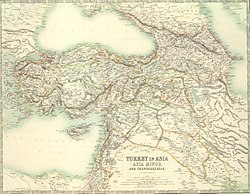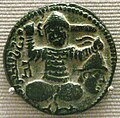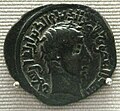Artuqids
The Artuqid dynasty (Artuklu in Turkish, sometimes also spelled as Artukid, Ortoqid or Ortokid; Turkish plural: Artukoğulları) was an Oghuz Turkish dynasty that ruled in Eastern Anatolia, Northern Syria and Northern Iraq in the eleventh and twelfth centuries. Two main branches of the dynasty ruled from Hasankeyf (Hısn-ı Keyf, Hısnkeyfa) between 1102–1231 and Mardin between 1106–1186 (and until 1409 as vassals). There was also a third branch that acquired Harput in 1112 and was independent between 1185–1233.
History
The dynasty was founded by Artuq, son of Eksük, a general originally under Malik Shah I and then under the Seljuk emir of Damascus, Tutush I. Tutush appointed Artuq governor of Jerusalem in 1086. Artuq died in 1091, and his sons Sokman and Ilghazi were expelled from Jerusalem by the Fatimid vizier al-Afdal Shahanshah in 1098; the Fatimids lost the city to the crusaders the following year.
Sokman and Ilghazi set themselves up in Diyarbakır, Mardin, and Hasankeyf in the Jezirah, where they came into conflict with the sultanate of Great Seljuk. Sokman, bey of Mardin, defeated the crusaders at the Battle of Harran in 1104. Ilghazi succeeded Sokman in Mardin and imposed his control over Aleppo at the request of the qadi Ibn al-Khashshab in 1118. In 1119 Ilgazi defeated the crusader Principality of Antioch at the Battle of Ager Sanguinis.
In 1121 a Seljuk-Artuqid alliance, commanded by Mehmed I of Great Seljuk and Ilghazi, was defeated by Georgia at the Battle of Didgori. Ilghazi died in 1122, and although his nephew Balak nominally controlled Aleppo, the city was really controlled by Ibn al-Khashshab. Al-Kashshab was assassinated in 1125, and Aleppo fell under the control of Zengi of Mosul. After the death of Balak, the Artuqids were split between Diyarbakır, Hasankeyf and Mardin. Sokman's son Davud, bey of Hasankeyf, died in 1144, and was succeeded by his son Kara Aslan. Kara Aslan allied with Joscelin II of Edessa against the Zengids, and while Joscelin was away in 1144, Zengi recaptured Edessa, the first of the Crusader states to fall (see Siege of Edessa). Hasankeyf became a vassal of Zengi as well.
Kara Aslan's son Nur ad-Din Muhammad allied with the Ayyubid sultan Saladin against the Sultan of Rum Kilij Arslan II, whose daughter had married Nur ad-Din Muhammad. In a peace settlement with Kilij Arslan, Saladin gained control of Artuqid territory, although the Artuqids were still technically vassals of Mosul, which Saladin did not yet control. With Artuqid support Saladin eventually took control of Mosul as well.
The Artuklu dynasty still nominally controlled the upper Mesopotamia but their power declined under Ayyubid rule. Hasankeyf branch conquered Diyarbakır in 1198 and moved her. This branch was demolished by Ayyubids in 1231 due to she sought alliance with Seljuks. Harput branch was ended by Sultanate of Rum due to she followed slippery policy between Ayyubids and Seljuks. Mardin branch was vassal of Ayyubids, Sultanate of Rum, Il-Khanate and Timurid. Finally, Karakoyunlu captured Mardin and end Artuklu rule in 1409.
Art
Despite their constant preoccupation with war, members of the Artuklu dynasty left brilliant architectural monuments.
They made the most significant additions to Diyarbakır City Walls. Urfa Gate was rebuilt by Muhammad, son of Kara Arslan. In the same area of the western wall, south of Urfa Gate, two imposing towers, Ulu Beden and Yedi Kardeş were commissioned in 1208 by the Artuklu ruler Salih Mahmud who designed the Yedi Kardeş tower himself and apposed the Artukid double-headed eagle on its walls.
A large caravanserai in Mardin as well as the civil engineering feat of Malabadi Bridge are still in regular use in our day. The partially standing Hasankeyf Bridge was built in 1116 by Kara Arslan.
The Great Mosques of Mardin and Silvan were possibly but in any case considerably developed over the 12th century by several Artuklu rulers on the basis of existing Seljuk edifices. The congregational mosque of Dunaysir (now Kızıltepe) was commissioned by Artuklu Bey Yülük Arslan (1184–1203) and completed after his death in 1204 by his brother Artuk Arslan (1203–1239).
Coinage
External links
- (fact sheet) "[[Diyarbakır City Walls]], [[Diyarbakır]]". ArchNet.
{{cite web}}: Check|url=value (help); URL–wikilink conflict (help) - (fact sheet) "[[Malabadi Bridge]]". ArchNet.
{{cite web}}: Check|url=value (help); URL–wikilink conflict (help) - (fact sheet) "Hasankeyf Bridge, [[Hasankeyf]]". ArchNet.
{{cite web}}: Check|url=value (help); URL–wikilink conflict (help) - (fact sheet) "Great Mosque (Ulu Cami) of [[Mardin]]". ArchNet.
{{cite web}}: Check|url=value (help); URL–wikilink conflict (help) - (fact sheet) "Great Mosque (Ulu Cami) of Meyyafarikin (now [[Silvan]])". ArchNet.
{{cite web}}: Check|url=value (help); URL–wikilink conflict (help) - (fact sheet) "Great Mosque (Ulu Cami) of Dunaysir (now [[Kızıltepe]])". ArchNet.
{{cite web}}: Check|url=value (help); URL–wikilink conflict (help) - Mustafa Güler, İlknur Aktuğ Kolay. (full text) "12. yüzyıl Anadolu Türk Camileri (12th century Turkish mosques in Anatolia" (in Turkish). Istanbul Technical University Magazine (İtüdergi).
{{cite web}}: Check|url=value (help); Italic or bold markup not allowed in:|publisher=(help) - (timeline) "History of Artuklu Dynasty" (in Turkish). http://www.dallog.com.
{{cite web}}: Check|url=value (help); External link in|publisher=
Sources
- (limited preview) Clifford Edmund Bosworth (2004). The New Islamic Dynasties: A Chronological and Genealogical Manual ISBN 0748621377. Edinburgh University Press.
- Carole Hillenbrand, A Muslim Principality in Crusader Times: The Early Artuqid State. Nederlands Historisch-Archaeologisch Instituut, 1990.
- Carole Hillenbrand, The Crusades: Islamic Perspectives. Routledge, 2000.
- (Book cover) Oktay Aslanapa (1991). Anadolu'da ilk Türk mimarisi: Başlangıcı ve gelişmesi (Early Turkish architecture in Anatolia: Beginnings and development) ISBN 975-16-0264-5 (in Turkish). AKM Publications, Ankara.
- P.M. Holt, The Age of the Crusades: The Near East from the Eleventh Century to 1517. Longman, 1989.
- Steven Runciman, A History of the Crusades, vol. II. Cambridge University Press, 1952.
- Kenneth Setton, ed., A History of the Crusades. Madison: 1969–1989 (available online).
| History of Turkey |
|---|
 |
| Timeline |
|
|



